Regalia
Mi’kmaq and Maliseets beadworkers also produced items, such as purses and tea cozies, for a non-Native market. Yet among the Penobscot and Passamaquoddy beadwork appears to have been reserved for the decoration of personal regalia.
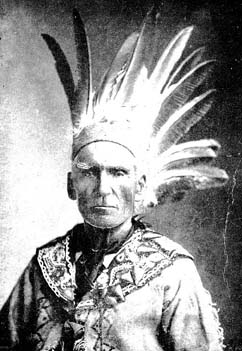 |
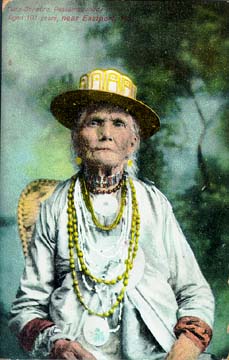 |
Penobscot men wore distinctive ceremonial regalia consisting of cape collars and cuffs. The oldest extant collars combine beadwork done in double-curve motifs with ribbon appliqué around the outer border of the collar. In the mid-1800s, beaded double-curve designs combined with ribbon appliqué work gave way to beaded floral motifs. Background fabrics were usually red or black and the collar consisted of three sections—a back yoke and two front panels.
Later collars, incorporaring double curves, floral motifs and even whirling log designs borrowed from the Navajos, were made on fabric or leather. These collars, beaded in one piece, mostly date to the early 20th century.
Penobscot Cape Collar and Cuffs, c.1860-1870
|
“After our ancestors made tools, they embellished them. The act of enhancement seems to be a very basic part of the human experience. It is our human history. As we examine visual records of our past, we are able to locate ourselves in the present. It is important to enjoy these beaded pieces as beautiful forms as well as studying them as a significant part of our shared past. Art is the forming of a vision into material reality. When art is succesful, it feels complete in an emotional, non-intellectual way. It also becomes a bridge from one time, culture, maker to another. When examining the Maliseet amice, or belt, it is enjoyable to follow with one’s eyes the design elements as they ‘dance’ along the length of the piece.
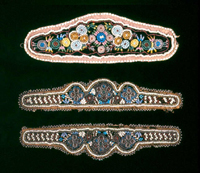 |
Maliseet Epaulets, c.1840
|
The color relates to an earlier Native palette of white, blue, gray instead of black and the addition of shades of red. There is a ‘naturalness’ to the beading as if the beads grew there. There is also an underwater quality such as the incrustations one might see on shells. And so we can imagine that the beader might have been familiar with tidal flats and enjoyed wading along the beach.
Possible Maliseet Amice(Ecclesiastical Collar), c.1850Nancy & Roger Prince (NTP49) |
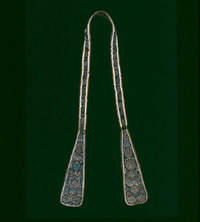 |
How different is the interpretation of flowers and ferns on the pouches. The sunflower forms are bold and formal. The strawberry colors and clover forms on the Glengarry cap look delicious and fragrant. Each piece reflects the beader’s history, her environment and her ideas about the marketplace where her work was sold.
It is remarkable that so many of these delicate pieces have survived and attest to the value placed on them by their owners.”
—Exhibit co-curator Nancy T. Prince

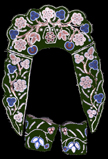 Historic photographs from the late nineteenth and early twentieth centuries show Peter Nicola, among others, wearing this cape collar and cuffs. Later photos show the collar being worn by Chief Blue-jay, Wor-bur-ban (Walter Ranco). Originally the fabric was black, but over time the background material has faded to olive.
Historic photographs from the late nineteenth and early twentieth centuries show Peter Nicola, among others, wearing this cape collar and cuffs. Later photos show the collar being worn by Chief Blue-jay, Wor-bur-ban (Walter Ranco). Originally the fabric was black, but over time the background material has faded to olive.